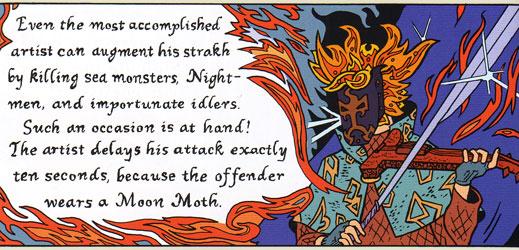Originally a Japan-only PS2 release way back in 2003, Growlanser IV was remade with expanded content and new characters for the PSP system in Japan last year. This time around, they opted for an English-language release to follow.
And it’s actually a little surprising we didn’t see this title in North America after its initial release nine years ago. The story isn’t too far “out there” — one of those untranslateables which, in the old days, just didn’t seem like they could flourish outside the Japanese milieu. In fact, after a slow start, the characters and storyline are entirely decent in this very playable, though admittedly, high-difficulty TRPG.
Marketing mysteries aside, the sprite-based, classic gameplay is the sort that ages well in the bottle. With the updated content, there’s no sense that this is a decade-old game, nor that it was ever intended for anything other than than a Playstation Portable system, as is the case sometimes with simple ports.
Despite the fact that this game is fourth in a series, the story and characters appear to stand entirely alone. The narrative revolves around a character named Creville, the archetypical “silent protagonist” of RPG convention, whose only dialogue is selected by the player in a multiple-choice fashion. We find out early on that he is a so-called “Ruin Child”, individuals found in a technological stasis in the few remaining structures from an ancient civilization.
The same threat that wiped out this advanced ancestral culture, some 2000 years before the events of the game, may be arising again. However, these mysterious forces, in the guise of city-destroying angels, almost fall to the background for much of the game, as no less than four different countries wage war against each other.
Starting out as members of a mercenary band, the characters fighting both on and alongside your team shift allegiances several times, ultmately battling with and against the members of several nations’ armies. The discovery of ancient magical spells are treated as a major tactical advantage, since initially, only one nation has access to them.
(The player also has the option of unlocking better and more powerful spell abilities of his own by performing sidequests and putting supporting members of the team to work on magical research.)
Combat-wise, tactics overshadow level-grinding as the big timesuck in this title. Rather than spending hours clicking “attack” in dungeon runs, the player can expect to put in the same hours going through the same boss battles until the trick to undoing the enemy defense becomes clear. This is particularly true with extra-challenging clear conditions that vary from rescuing hostages, defending strategic routes, and guarding VIPs.
A plethora of special abilities and accessories (everything from stealth skills which allow Creville to more closely approach an enemy before beginning a battle, to random chances of inflicting or resisting status effects) make preparations before a big battle as important as commands in the fight itself. Side missions and non-battle activities at the home base, including business ventures, weapons research, and, oddly, city planning, all ultimately feed into supporting the player’s fighting power. It’s a sort of “supply lines” strategy aspect to the game that I found unusual and interesting.
Atypically for a TRPG, battles are active time rather than strictly turn-based, and movement is analog instead of based on a grid. More typically for a TRPG, boss battles (which usually feature tough odds against overwhelming numbers of enemy soldiers) are usually an affair of 30 minutes to over an hour. Never get complacent. Much like a game of chess, it’s not over until it’s over. Victory can be snatched away, even in the final minutes of a campaign.
On the whole, I found the game often frustrating, but remarkably addictive, and ultimately rewarding. The story and characters aren’t going down in gaming history for me, but the gameplay is interesting and challenging, and the engaging and plausible way the non-battle elements of the game tie in with field tactics put this one over the top for me. Recommended.
Article first published as PSP Review: Growlanswer IV: Wayfarer of Time on Blogcritics.
